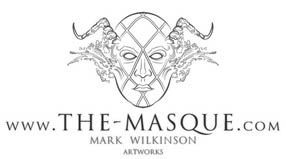
Greg interviews Mark Wilkinson (2015)
Q. You first met Paul after working on his book ‘Beyond Time and Place’. How did that come about?
“Paul was working on his book ‘Beyond Time and Place’ and he needed a designer, someone to put it together. He’d seen my book ‘Shadowplay’ and liked the style. I designed that myself and so that’s how it really started, me designing Paul’s book. When I started working on the book, I knew he’d done stuff for Saxon and other album sleeves, but I didn’t know about all the Tolkien work. That just absolutely blew me away and I just could not believe that I’d never seen this work before. The work in the book is just breathtaking and I think he’s one of the best. I later went to Bloodstock at his invitation to actually meet him. I thought Bloodstock was brilliantly run and I can’t praise it enough. It’s like one big happy family.”
Q. Like Paul, you’re also well known for your rock and metal album artwork, with your sleeves for Marillion being the most iconic. It seems that within the rock and metal genres, there’s a lot to work with in terms of coming up with visual concepts and ideas?
“Yeah, there is. The iconography of metal artwork is often fantasy orientated. Before I got involved with Marillion I was doing science fiction and horror book covers and I’d always been interested in fantasy art and album cover art. With album covers, it’s almost like a shorthand. You’ve got to find something really powerful to draw people in. In the old days, it was to draw people into the record shops and get them to look through the racks and to stop at a particular album because it fascinates you in some way. If it fascinates you enough but you don’t know who the band is you might actually buy it. Then suddenly it became much more than that. It became an identity for the band that they could use on tour to promote themselves and be recognized. Roger Dean said about his Asia logo that when the record company complained that people wouldn’t be able to read it, he said that you’re not supposed to read it, you’re supposed to recognize it. With a lot of metal album covers you don’t necessarily read it. It becomes a brand, an identity. If you see the logo for Metallica or whatever, you instantly know who it is and what kind of music it is. So it’s become very important from that point of view.”
Q. You visited the Rock and Metal Gallery at Bloodstock in 2014, and in 2015 you’re going to have some of your own work on display. What was your impression of the gallery?
“Well, I was astonished at that, absolutely astonished. Maybe I shouldn’t have been astonished because it’s Paul and he always does things really well. He puts a lot of work into things and this is why Bloodstock has matured into the festival that it is, but to have a gallery on site – well, I don’t know what I was expecting. I thought it’d just be a marquee and you’d walk in and there’d be a few easels up or whatever, but this is a purpose built gallery with flooring, a big lighting rig, and it was beautifully put together. It’s like walking into a proper West End gallery and yet it’s on the site of a festival. It’s quite astonishing. To make a permanent exhibition somewhere is a fantastic idea and I think there would be a huge amount of interest. At Bloodstock this year I’m going to have some limited edition art prints and some will be for sale. I’ve done work for all sorts of people like Judas Priest, Iron Maiden, and The Darkness, and I’ll be showing a selection of different work. I’ve crossed from heavy metal to prog rock and even pop with Kylie! I hope people will be surprised.”
